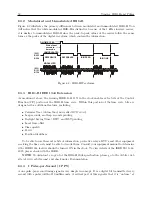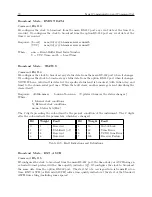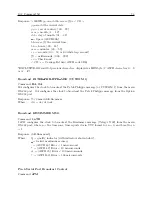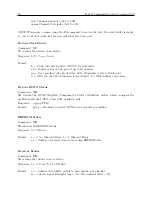
Chapter 10
Serial Communication and Command
Set
10.1
Introduction
Models 1092A/B/C and 1093A/B/C have one main RS-232 port, and one optional RS-232 port.
These are labeled
RS-232C
and
Option RS-232
. When viewing the rear panel, the main port is
nearest the antenna connector and the optional port is to the left of the Standard I/O connectors.
RS-232 combines an RS-485 function in the same connector if Option 94 is installed.
It is important
to note that the Option RS-232 port does not support RS-485, neither RS-232 ports use flow control,
and the RS-485 port functions in transmit only mode
.
Use the two serial ports interchangeably for separate functions. You may wish to interrogate the
clock on one port for basic information (i.e to configure something) and at the same time be able
to have the second serial port broadcasting a specific time code to a meter. While most substation
IEDs appear to have standardized on the IRIG-B time code, some devices are designed to receive
ASCII data through the serial port. Another common serial-port function is to connect a digital
wall display to indicate the time.
10.2
Command Set
This section provides information for controlling and communicating with these clocks via the RS-
232C serial interface. All off the RS-232 commands are functionally grouped into similar categories.
For example, Section 10.2.3 lists all of the commands used to broadcast the date and time in one
of the standard formats.
Each command name and syntax is highlighted in bold at the beginning of each definition.
Detailed information used to interpret the commands and responses follows each command heading.
Sometimes the command is very short, such as the command to return the Local Time:
TL
. Other
commands require a prefix or suffix with the letter command to specify them, such as to broadcast:
Bn
, where n = an integer specifying the broadcast. For example, the command to start the ASCII
Standard broadcast string at a rate of once per second, on Local time, from the main RS-232 port
is
B1
.
When a command requests information from a clock, it returns the most current data available.
Numeric data is returned as an ASCII string of numeric characters, with leading sign and embedded
Summary of Contents for 1092A
Page 4: ...iv ...
Page 18: ...xviii LIST OF TABLES ...
Page 129: ...C 10 Option 20A Four Fiber Optic Outputs 111 Figure C 7 Option 20A Jumper Locations ...
Page 131: ...C 11 Option 27 8 Channel High Drive 113 Figure C 8 Option 27 Jumper Locations ...
Page 148: ...130 Options List Figure C 10 Option 29 Connector Signal Locations ...
















































